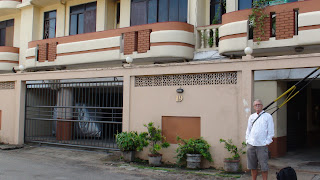Whole Village Concept
 |
| village temple cart at Point Pedro |
Anyway, he offered to take us out to one of his housing projects, so the next time we met up with him, I called in the offer. He picked us up in his Land Rover and off we went on a very educational tour. Through lessons learned by their tsunami projects, the NGO has now adopted a Whole Village Concept to housing.
This process begins with identification of those in need of housing. This is not done by income, as there is little reliable documentation on income. Therefore, people who request relocation and/or who are identified as needing relocation are offered an opportunity to resettle elsewhere. This is a very difficult decision for Sri Lankan people as their “ancient village” gama (Sinhala) or oru (Tamil) is very important to them.
Once it is established who is eligible and once the property has been secured (usually leased through government) the NGO must then establish water. Wells are divined and dug or large basins are made to allow for fresh water. Sometimes, these wells are not in the center of the village, but in the center of a rice paddy. Then, a school house needs to be established.
We hopped the high concrete compound fencing in the grade school to see the classrooms. They are bright, airy and equipped with desks and some computers. Fresh water for drinking is collected from rain water, stored in tanks, and a system for removing bird feces was installed, before the water goes to a chlorination tank and storage tank for drinking.
The homes themselves are all the same. Two bedrooms, a kitchen, a bathroom, and a living room are provided. Construction is post and beam ceilings, cement walls and flooring, red ceramic tile roofing. Each family has a small yard, about the size of a Nicola St. yard. Palmyra trees are planted as this is the heart of the Tamil community: sap for drinking, sap for alcohol, leaves for baskets and fencing, wood for construction and framing, some medicinal properties along with many other uses. However, due the high salt content in the soil, vegetables cannot be grown. Therefore, all produce must come from markets that unfortunately, are sometimes in excess of 2 kilometers away. These markets serve the “hamlets” of about 40 homes. I think there were four hamlets in the location we viewed.
 |
| housing project after Tsunami and displacment |
Diaspora from around the world are generously assisting with the erection of Hindu temples and Christian Churches in the villages, but also each caste must have their own church as there are quite strict rules about worship within castes. Often too, the mason caste, for instance, which might only be one family in the village, may also need their own family/caste church.
Other issues that have arisen from these housing projects are that not all NGO’S are the same. Some have more money than others, some are more willing to listen to the needs/desires of the people and some families have private money to add to the NGO funding. All these create jealousies and factions that affect the community as a whole.
However, all in all, the villages are lovely, treed, green, have fresh water, places of worship and schools. I keep thinking about Maslow’s Hierarchy of Needs. Now that issues of safety and security are met for people, who for some, have been living in tents or temporary shelters for so many years, there can only be positive change as they begin to build a sense of belonging, a sense of community and build toward self-actualization.



Comments
Post a Comment